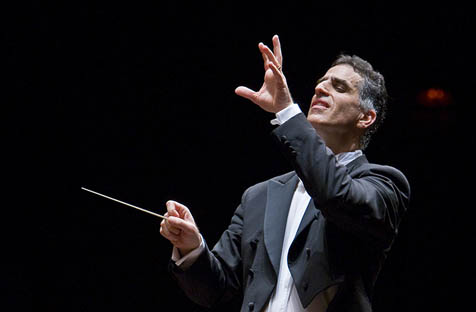Santa Barbara Symphony Maestro Nir Kabaretti on the New Season
S.B. Symphony Season to Include Works by Contemporary Composers

After a stellar first year, a surprise visit in September from a bona-fide superstar (Lang Lang), and a successful concert to begin his second season, Maestro Nir Kabaretti has prepared the Santa Barbara Symphony to present some very adventurous contemporary works in the months to come in 2009-10 at the Granada. Kabaretti explained these bold programming moves-and how he balances them with more familiar works-when I spoke with him last week.
The concerts this weekend feature a joint performance with the Santa Barbara Choral Society of Haydn’s Paukenmesse. What inspired your choice of this relatively unknown work? I love Haydn, and I love collaborating with JoAnne Wasserman and the Santa Barbara Choral Society. This work has a scary name that means “kettle-drum mass,” but it’s actually very peaceful. It contains both a religious element, and a symphonic, artistic element, and it’s so important that the symphony perform vocal music as well as purely symphonic works.
In January, you’re performing something by a composer very few people know at all, Andre Mathieu. How did that work come your way? This is practically an unknown piece to audiences in the United States, but Mathieu is very important to Canada, his homeland, and he had a very tragic life, dying young. He began his career in Canada, then moved to Europe, and wrote some marvelous music for piano, including this concerto [No. 4]. I think he’s one of the most important composers of the 20th century, and there will be a renaissance of interest in him-we really should appreciate this man. We’re playing it along with a symphony by Cesar Franck, the Belgian composer, and although neither composer was French, there’s a very French feeling to this-both of them studied in France. You know, I think it’s my duty to introduce the audience to new works and to provide them not only with well-known, but also unknown works. It’s both a responsibility and a challenge to choose those works I think will blend in with a normal season for a symphony orchestra. We’ve got such a wonderful musical community here that I know people will respond.
That mix of known and unknown works is especially visible in the spring concerts-you’ve got Osvaldo Golijov’s Ausencia in March and Hindemith’s Concert Music for Strings and Brass in April. The Golijov piece is just wonderful-he’s the most sought-after composer in the world these days. I’ve listened to his music for a long time, and it’s all great: his operas and his other music, too. He has such a beautiful touch; the music comes right to your heart. We have a great cellist coming, too, Joshua Roman, and I thought the Tchaikovsky Variations on a Rococo Theme and Golijov’s Ausencia would work perfectly when played back-to-back. Also, you should know that the April concert-with Hindemith, Rachmaninoff, and Joseph Schwantner’s Chasing Light :-consists entirely of works that premiered in the United States. Even the Rachmaninoff [Piano Concerto No. 3 in D Minor, Op. 30], which was played by the composer himself, was first performed in America. In this performance, the pianist will be Jeffrey Kahane, whom I first saw when he won the Rubinstein Competition 20 years ago, when I was a contestant, too. I heard him play then, and he had this wild, long hair, and he was just amazing. He’s now the conductor of the Los Angeles Chamber Orchestra, and it’s nice to come full circle with him and have him come up here to perform after having seen him all those years ago. The Schwantner piece will be our own premiere-and history will let us know in a century or two whether this work was destined to join the permanent repertoire.
I’m sure history will judge your choices kindly.
4•1•1
The Santa Barbara Symphony will play Mozart and Haydn at the Granada Theatre (1214 State St.) on Saturday, November 7, and Sunday, November 8. Call 898-9386 or visit thesymphony.org for details.



